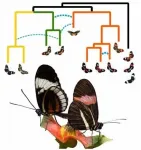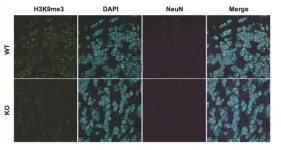(Press-News.org) A team of researchers from the University of Maryland has 3D printed a soft robotic hand that is agile enough to play Nintendo's Super Mario Bros. - and win!
The feat, highlighted on the front cover of the latest issue of Science Advances, demonstrates a promising innovation in the field of soft robotics, which centers on creating new types of flexible, inflatable robots that are powered using water or air rather than electricity. The inherent safety and adaptability of soft robots has sparked interest in their use for applications like prosthetics and biomedical devices. Unfortunately, controlling the fluids that make these soft robots bend and move has been especially difficult - until now.
The key breakthrough by the team, led by University of Maryland assistant professor of mechanical engineering Ryan D. Sochol, was the ability to 3D print fully assembled soft robots with integrated fluidic circuits in a single step.
"Previously, each finger of a soft robotic hand would typically need its own control line, which can limit portability and usefulness," explains co-first author Joshua Hubbard, who performed the research during his time as an undergraduate researcher in Sochol's Bioinspired Advanced Manufacturing (BAM) Laboratory at UMD. "But by 3D printing the soft robotic hand with our integrated fluidic transistors, it can play Nintendo based on just one pressure input."
As a demonstration, the team designed an integrated fluidic circuit that allowed the hand to operate in response to the strength of a single control pressure. For example, applying a low pressure caused only the first finger to press the Nintendo controller to make Mario walk, while a high pressure led to Mario jumping. Guided by a set program that autonomously switched between off, low, medium, and high pressures, the robotic hand was able to press the buttons on the controller to successfully complete the first level of Super Mario Bros. in less than 90 seconds.
"Recently, several groups have tried to harness fluidic circuits to enhance the autonomy of soft robots," said recent Ph.D. graduate and co-first author of the study Ruben Acevedo, "but the methods for building and integrating those fluidic circuits with the robots can take days to weeks, with a high degree of manual labor and technical skill."
To overcome these barriers, the team turned to "PolyJet 3D Printing," which is like using a color printer, but with many layers of multi-material 'inks' stacked on top of one another in 3D.
"Within the span of one day and with minor labor, researchers can now go from pressing start on a 3D printer to having complete soft robots - including all of the soft actuators, fluidic circuit elements, and body features - ready to use," said study co-author Kristen Edwards.
The choice to validate their strategy by beating the first level of Super Mario Bros. in real time was motivated by science just as much as it was by fun. Because the video game's timing and level make-up are established, and just a single mistake can lead to an immediate game over, playing Mario provided a new means for evaluating soft robot performance that is uniquely challenging in a manner not typically tackled in the field.
In addition to the Nintendo-playing robotic hand, Sochol's team also reported terrapin turtle-inspired soft robots in their paper. The terrapin happens to be UMD's official mascot, and all of the team's soft robots were printed at UMD's Terrapin Works 3D Printing Hub.
Another important benefit of the team's strategy is that it's open source, with the paper open access for anyone to read as well as a link in the supplementary materials to a GitHub with all of the electronic design files from their work.
"We are freely sharing all of our design files so that anyone can readily download, modify on demand, and 3D print - whether with their own printer or through a printing service like us - all of the soft robots and fluidic circuit elements from our work," said Sochol. "It is our hope that this open-source 3D printing strategy will broaden accessibility, dissemination, reproducibility, and adoption of soft robots with integrated fluidic circuits and, in turn, accelerate advancement in the field."
At present, the team is exploring the use of their technique for biomedical applications including rehabilitation devices, surgical tools, and customizable prosthetics. As Sochol is a faculty affiliate of the Fischell Department of Bioengineering as well as a member of both the Maryland Robotics Center and the Robert E. Fischell Institute for Biomedical Devices, the team has an exceptional environment to continue advancing their strategy to address pressing challenges in biomedical fields.
INFORMATION:
The A. James Clark School of Engineering at the University of Maryland serves as the catalyst for high-quality research, innovation, and learning, delivering on a promise that all graduates will leave ready to impact the Grand Challenges of the 21st century. The Clark School is dedicated to leading and transforming the engineering discipline and profession, to accelerating entrepreneurship, and to transforming research and learning activities into new innovations that benefit millions.
Evolution is often portrayed as a tree, with new species branching off from existing lineages, never again to meet. The truth however is often much messier. In the case of adaptive radiation, in which species diversify rapidly to fill different ecological niches, it can be difficult to resolve relationships, and the phylogeny (i.e. evolutionary tree) may look more like a bush than a tree. This is because lineages may continue to interbreed as new species are established, and/or they may diverge and then re-hybridize, resulting in genetically mixed populations (known as admixture). Even after species diverge, the introduction of genes from one species to another (known as introgression) can occur. All of ...
A UC San Francisco study has found that the antibiotic azithromycin was no more effective than a placebo in preventing symptoms of COVID-19 among non-hospitalized patients, and may increase their chance of hospitalization, despite widespread prescription of the antibiotic for the disease.
"These findings do not support the routine use of azithromycin for outpatient SARS-CoV-2 infection," said lead author Catherine E. Oldenburg, ScD, MPH, an assistant professor with the UCSF Proctor Foundation. SARS-CoV-2 is the virus that causes COVID-19.
Azithromycin, a broad-spectrum antibiotic, is widely prescribed as a treatment for COVID-19 in the United States and the rest of the world. "The hypothesis is that it has anti-inflammatory properties that ...
ATLANTA--An oral prodrug developed by a team of scientists led by Binghe Wang, Regents' Professor of Chemistry at Georgia State University, delivers carbon monoxide to protect against acute kidney injury, according to a new paper published in Chemical Science.
Although carbon monoxide (CO) gas is toxic in large doses, scientists have discovered it can have beneficial effects by reducing inflammation and protecting cells against injury. Previous studies have demonstrated the protective effects of CO against injury in the kidneys, lungs, gastrointestinal tract and liver, among other organs. For the past five years, Wang and his collaborators have worked to design a safe way to deliver CO to human patients via prodrugs -- inactive compounds that ...
The COVID-19 pandemic knocked many women off schedule for important health appointments, a new study finds, and many didn't get back on schedule even after clinics reopened. The effect may have been greatest in areas where such care is already likely falling behind experts' recommendations.
The study, by health care researchers in the University of Michigan END ...
The hydrothermal vent fluids from the Gorda Ridge spreading center in the northeast Pacific Ocean create a biological hub of activity in the deep sea. There, in the dark ocean, a unique food web thrives not on photosynthesis but rather on chemical energy from the venting fluids. Among the creatures having a field day feasting at the Gorda Ridge vents is a diverse assortment of microbial eukaryotes, or protists, that graze on chemosynthetic bacteria and archaea.
This protistan grazing, which is a key mechanism for carbon transport and recycling in microbial food webs, exerts a higher predation pressure at hydrothermal vent sites than in the surrounding deep-sea environment, a new paper finds.
"Our ...
Vaccine negativity and reluctance didn't just emerge during the COVID-19 pandemic. In a recent study published in the Disaster Medicine and Public Health Preparedness journal, authors from Loyola University Maryland and Johns Hopkins Bloomberg School of Public Health explored the appearance of negative dominance - a concept in which negative messages outweigh positive, solution-oriented messages in audiences' perceptions - in the context of COVID-19 vaccine-related information and activity online.
Prior research has looked at media coverage to identify vaccine concerns among the public and its impact on vaccine-related beliefs and behaviors, the spread of misinformation and fake news on the Internet, and the role ...
New research from the RIKEN Center for Brain Science (CBS) in Japan shows that a deficit in histone methylation could lead to the development of autism spectrum disorders (ASD). A human variant of the SUV39H2 gene led researchers to examine its absence in mice. Published in Molecular Psychiatry, the study found that when absent, adult mice exhibited cognitive inflexibility similar to what occurs in autism, and embryonic mice showed misregulated expression of genes related to brain development. These findings represent the first direct link between the SUV39H2 gene and ASD.
Genes are turned ...
What The Study Did: The association between primary care payment models and the use of telemedicine for Medicare Advantage enrollees during the COVID-19 pandemic was examined in this study.
Authors: Brian W. Powers, M.D., M.B.A., of Humana Inc. in Louisville, Kentucky, is the corresponding author.
To access the embargoed study: Visit our For The Media website at this link https://media.jamanetwork.com/
(doi:10.1001/jamahealthforum.2021.1597)
Editor's Note: The article includes conflicts of interest disclosures. Please see the article for additional information, including other authors, author ...
What The Study Did: Researchers investigated whether death, other hospital outcomes and processes of care differed between patients cared for by female and male physicians at hospitals in Canada.
Authors: Fahad Razak, M.D., M.Sc., of the University of Toronto in Ontario, Canada, is the corresponding author.
To access the embargoed study: Visit our For The Media website at this link https://media.jamanetwork.com/
(doi:10.1001/jamahealthforum.2021.1615)
Editor's Note: The article includes conflicts of interest disclosures. Please see the article for additional information, including other authors, author contributions and affiliations, conflict of interest and financial disclosures, and funding and support.
# # #
Media advisory: The full study is linked to this news ...
What The Study Did: National health care systems have different capacities to correctly identify people who died of COVID-19. Researchers in this study analyzed the gap between excess mortality and COVID-19 confirmed mortality in 67 countries to determine the extent to which official data on COVID-19 deaths might be considered reliable.
Authors: Davide Golinelli, M.D., Alma Mater Studiorum-University of Bologna in Italy, is the corresponding author.
To access the embargoed study: Visit our For The Media website at this link https://media.jamanetwork.com/
(doi:10.1001/jamanetworkopen.2021.17359)
Editor's ...


